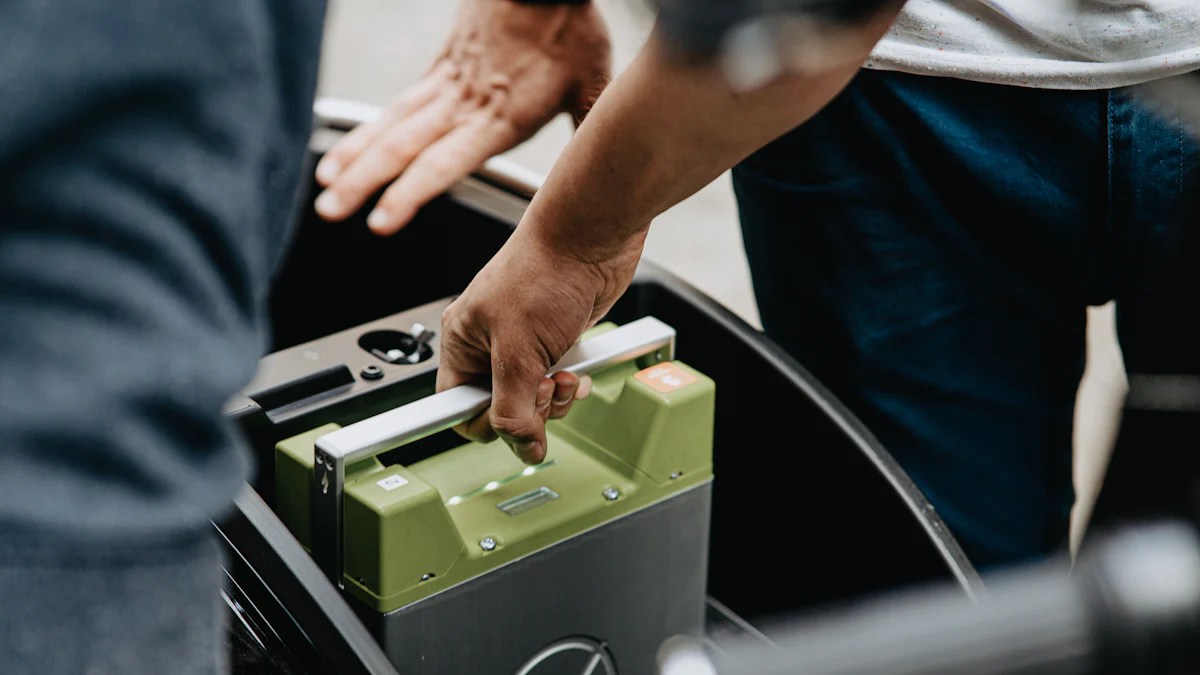Unveiling the Power of Lithium-Ion Batteries

Image Source: unsplash
The Growing Demand for Energy Storage
Energy storage is vital in modern industry, with the demand for efficient solutions on the rise. Analysts expect the global energy storage market to grow significantly, reaching 512.41 GW by 2030.
The ternary lithium battery has emerged as a key player in this field, offering high energy density and efficiency. Industries increasingly rely on the ternary lithium battery for various applications. The versatility of the ternary lithium battery makes it indispensable, and its relevance continues to expand across sectors.
1. Understanding Ternary Lithium Batteries
Definition and Composition
Ternary lithium batteries have become essential in modern technology. These batteries contain three primary components: nickel, manganese, and cobalt. Nickel plays a crucial role in enhancing the energy density of the battery.
Manganese contributes to the stability and safety of the battery. Cobalt improves the overall performance and lifespan. The combination of these elements forms a polymer structure that ensures efficient energy storage.
The chemical structure of a ternary lithium battery enables high energy output. This structure allows for rapid charging and discharging cycles. The functionality of these batteries makes them suitable for various applications. Industries benefit from the adaptability of ternary lithium batteries.
Characteristics and Performance
Ternary lithium batteries offer remarkable energy density and efficiency. These batteries store more energy per unit of weight compared to other types. High energy density allows for longer usage times in devices. Efficiency in energy conversion reduces waste and enhances performance.
The lifespan of a ternary lithium battery is impressive. These batteries endure numerous charge and discharge cycles. Durability ensures long-term reliability in industrial applications. Improved safety features have increased the popularity of these batteries.
Ternary lithium batteries perform well in low-temperature conditions. Cold resistance ensures functionality in diverse environments. The fast charging capability meets the demands of modern technology. Industries rely on the consistent performance of ternary lithium batteries.
2. Comparison with Other Battery Types
Ternary Lithium Battery vs. Lithium Iron Phosphate (LFP)
Energy Capacity Comparison
Ternary lithium batteries offer high energy density. This feature allows more energy storage per unit of weight. Industries benefit from longer usage times and efficient performance.
Lithium Iron Phosphate (LFP) batteries provide lower energy density, focusing more on stability and safety. The choice between them depends on specific industrial needs.
Cost and Availability
LFP batteries remain less expensive than ternary lithium batteries. The materials used in LFP batteries contribute to lower production costs. Ternary lithium batteries involve higher costs due to nickel, manganese, and cobalt.
Market trends show LFP batteries gaining popularity for cost-effectiveness. Ternary lithium batteries attract industries needing high performance.
3. Ternary Lithium Battery vs. Lead-Acid Batteries
Environmental Impact
Lead-acid batteries have been the most common in energy storage. These batteries contain lead, which poses environmental risks, requiring careful handling during recycling.
Ternary lithium batteries offer a cleaner alternative. Nickel, manganese, and cobalt present fewer environmental concerns. Industries prefer ternary lithium batteries for sustainable practices.
Performance in Extreme Conditions
Ternary lithium batteries excel in extreme conditions. Low-temperature resistance ensures reliable performance and fast charging capabilities meet modern demands.
Lead-acid batteries struggle in harsh environments, with performance declining in cold temperatures. Ternary lithium batteries provide consistent efficiency, making them reliable for diverse applications.
4. Advantages of Ternary Lithium Batteries in Industry
High Energy Density
Ternary lithium batteries offer significant benefits for industrial applications. High energy density allows industries to store more energy in a smaller space. This feature supports longer operational times for machinery and equipment. Fast charging capabilities enhance productivity by reducing downtime. Industries can rely on ternary lithium batteries for efficient energy management.
Case Studies:
- Automotive Sector: Electric vehicles use ternary lithium batteries to achieve longer driving ranges. The high energy density supports extended travel without frequent recharging.
- Consumer Electronics: Portable devices benefit from the compact size and long-lasting power of these batteries. Users enjoy prolonged usage without constant charging interruptions.
Versatility and Adaptability
Ternary lithium batteries demonstrate versatility across various sectors. Industries such as automotive, electronics, and renewable energy utilize these batteries. The adaptability of ternary lithium batteries meets diverse energy needs. Customization options allow industries to tailor battery specifications.
Applications in Various Sectors:
- Renewable Energy: Solar and wind farms use these batteries for efficient energy storage. The batteries provide stability and reliability in energy supply.
- Power Tools: Construction and manufacturing industries benefit from the portability and power of ternary lithium batteries. Workers experience enhanced performance and convenience.
Customization for Specific Needs:
- Industries can adjust battery composition to suit specific applications. You can modify the ratios of nickel, manganese, and cobalt for optimal performance. Customization ensures that industries achieve desired energy outputs and efficiencies.
5. Potential Drawbacks and Challenges
Cost Considerations
Ternary lithium battery technology requires a significant initial investment. Industries often face high upfront costs due to the materials involved. Nickel, manganese, and cobalt contribute to these expenses.
Many businesses evaluate long-term savings when considering these batteries. High energy efficiency and durability can lead to reduced operational costs over time. Companies must weigh initial expenses against potential savings.
Market trends show fluctuations in pricing for ternary lithium batteries. Demand for these batteries continues to grow across various sectors. Prices may vary based on global supply chains and material availability. Industries must stay informed about market dynamics to make strategic decisions.
Environmental and Safety Concerns
Recycling and disposal of ternary lithium batteries present challenges. Proper management of battery waste ensures environmental safety.
The Mercury-Containing and Rechargeable Battery Act mandates recycling requirements. Businesses must comply with regulations to avoid environmental harm. Recycling processes must handle nickel, manganese, and cobalt responsibly.
Safety measures and regulations govern the use of ternary lithium batteries. The Universal Waste Rule provides guidelines for handling hazardous waste. Industries must follow these rules to ensure safe battery disposal.
Compliance with safety standards protects both the environment and human health. Regulatory frameworks guide industries in managing battery-related risks.
6. Future Prospects and Innovations

Image Source: unsplash
Technological Advancements
Research and Development Trends
Researchers explore new battery technologies to enhance efficiency and sustainability. Graphene batteries offer potential due to their high conductivity and flexibility. Lithium-sulfur batteries promise higher energy density compared to traditional lithium-ion batteries.
Sodium-ion batteries provide a cost-effective alternative with abundant raw materials. Iron-air and zinc-based batteries show promise for large-scale energy storage. Solid-state batteries lead the way with improved safety and energy density.
Emerging Technologies in Battery Design
Innovations in anode materials could revolutionize battery design. Silicon and lithium metal anodes may increase energy density significantly.
Solid-state batteries undergo experimentation for faster charging times. Companies like QuantumScape and Toyota pioneer solid-state EV battery technology. These advancements aim to transform power distribution and infrastructure efficiency.
Opportunities
Ternary lithium batteries have transformed energy storage in industry. The high energy density and efficiency of these batteries make them ideal for electric vehicles and renewable energy applications. Industries benefit from the fast charging and cold resistance features of ternary lithium batteries. The environmentally friendly nature of these batteries supports sustainable practices.
The future of industry will see increased reliance on ternary lithium batteries. These batteries offer a versatile solution for diverse energy needs. The continued innovation in battery technology promises even greater advancements.

